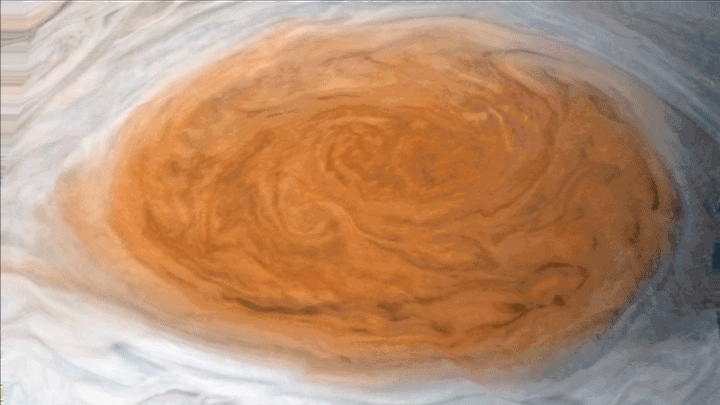What Lurks Below Jupiter’s Great Red Spot?
New results from the Juno spacecraft are helping to unlock the secrets of this centuries-old storm
/https://tf-cmsv2-smithsonianmag-media.s3.amazonaws.com/filer/4a/c2/4ac2276a-a3cb-4458-bd73-fbd3c646b32d/35491828673_faa9d0f5c2_k.jpg)
Jupiter’s Great Red Spot is one of the natural wonders of our solar system—a storm both instantly recognizable and still mysterious. This week, scientists announced new insights into the storm from data collected by the Juno spacecraft now in orbit around the gas giant.
Spanning over 10,000 miles across, the storm is roughly 1.3 times the diameter of the Earth. And now, using data collected during a close flyby in July, we know the spot’s storm stretches 200 miles deep.
The results were announced Monday at the American Geophysical Union Annual Meeting in New Orleans. "Juno found that the Great Red Spot's roots go 50 to 100 times deeper than Earth's oceans," said Andy Ingersoll, planetary scientist at Caltech, in a NASA press release.
The Juno spacecraft carries an array of instruments designed to peer at and into Jupiter’s clouds. The craft's measurements suggest that not only is the Great Red Spot deep, it’s also warmer at the base than it is at the top. The spot’s temperature rises from a chilly -279°F at the edge of Jupiter's atmosphere to more than 440°F at the base of the storm, reports Richard Chirgwin for The Register. Since temperature differences drive winds, this warm base might be the driver behind not just the red storm raging in Jupiter’s eye, but a hint at the engine driving all the storms swirling across the planet.
Jupiter’s clouds are a turbulent mix of mostly ammonia, methane, and water, Nina Godlewski reports for International Business Times. As for why Jupiter’s Great Red Spot is so red, that’s still a mystery although scientists are slowly pinning it down. As Jeff Hecht reported for New Scientist earlier this year, researchers are trying to produce the distinctive rusty color in laboratories by irradiating ammonia, abundant in the Jovian atmosphere, by mixing in traces of sulfides or the hydrocarbon acetylene—relatively sparse compounds in Red Planet skies.

The newest science results are paired with stunning images of Jupiter courtesy of the JunoCam and enthusiastic amateur photo processors. The JunoCam optical camera is the first camera mounted on a spacecraft primarily for outreach purposes, with its targets selected by fans and its data readily available for anyone to process.
The Great Red Spot is an ancient storm, one that’s been seething for at least 350 years. But it’s a storm, and like all storms, it will one day die down. While the Great Red Spot was measured at an impressive 10,159 miles in diameter in April 2017, that’s smaller than it used to be. When monitoring began in 1830, the storm was more than twice the diameter of the Earth. But by the time the Voyager 1 and 2 spacecraft flew by in 1979, the storm was smaller, yet still over twice the diameter of the Earth. Recently, it’s declining even faster at around 580 miles per year, although since we’re still learning why it’s shrinking, the smaller-but-still-great red spot might stabilize at its new smaller size.
Since its arrival at Jupiter in July last year, the Juno spacecraft has made eight close-approach passes over the Red Planet. Every 53 days, the spacecraft comes within 2,100 miles of Jupiter’s clouds, says Godlewski. The ninth of twelve scheduled science orbits will take place on December 16, 2017.

